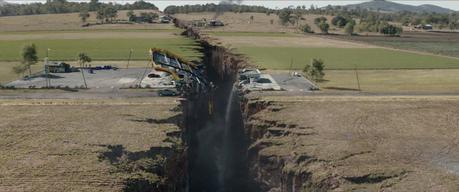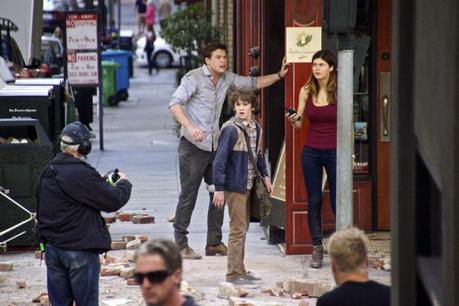My mind was blown the first time I heard that there is an active supervolcano underneath Yellowstone National Park. Wait, supervolcano? Volcanoes are already pretty bad as it is. Just ask Pompeii. Why did there also have to be supervolcanoes? These things are so bad they can wipe out entire continents, kickstart a new ice age, and generally eliminate an entire species, and we have one of them directly below one of our National Parks? If that thing goes off we’re all pretty screwed, and that’s exactly what happens in the Roland Emmerich disaster movie 2012, although in that case the eruption is part of a series of apocalyptic events including an earthquake so severe it drops California into the ocean.
Of course, after seeing a movie like 2012 it invariably leads to questions like, “Could that really happen?” to which some scientist usually says, “Sort of, but they took some dramatic liberties.” Now, Dwayne Johnson’s San Andreas is out, dramatizing and exaggerating the very real possibility of California suffering a series of severe earthquakes along the San Andreas Fault. In the film, Johnson plays a recently divorced, Los Angeles Fire Department rescue-helicopter pilot. When Nevada suffers a 7.1 quake followed by a 9.1 in Los Angeles and 9.6 in San Francisco, Johnson chooses to use his helicopter to try and save his ex-wife (Carla Cugino) and adult daughter (Alexandra Daddario), proving that cinematic first responders need not bother with saving anyone they don’t know. The exact likelihood of the San Andreas Fault triggering a series of severe earthquakes at some point in the next 30 years has been estimated to fall somewhere between 21% and 59%, calling to mind nervous memories of the 1989 earthquake which postponed Game 3 of the World Series at Candlestick Park and the 1906 San Francisco quake.

This is apparently total bullshit, but it sure looks cool
As such, this is exactly the time to ask how much San Andreas actually gets right in terms of the hard science. According to seismologist Lucy Jones, surprise, surprise, everything in the film is greatly exaggerated. In an op-ed for The Hollywood Reporter, Jones writes:
Both the magnitude of the shaking and the damage displayed are exaggerated beyond reality. Magnitude 9 earthquakes only occur on “subduction zones,” places where tectonic plates collide, pushing one plate under another and deforming the sea floor to create tsunamis. It has been millions of years since there was an active subduction zone under Los Angeles or San Francisco. The modern day San Andreas Fault maxes out at about magnitude 8.3, and, being mostly on land, will never produce a big tsunami. The level of destruction portrayed in the movie is over-the-top, collapsing high rises with heedless abandon. The gaping chasm we see rupturing the San Andreas in central California belongs to the realm of the completely impossible. If the fault could open up like that, there would be no friction — and without friction there would be no earthquake.
And how exactly did Jones respond to the idea of Paul Giamatti’s character being a heroic seismologist who predicts when the earthquakes are going to occur?
We seismologists sure wish we could do so, but we have yet to find any way to foresee the time of a particular earthquake. Magnetic and electric signals, strain meters and even animal behavior have been studied without success. The only time we know an earthquake becomes more likely is right after another one because of earthquake triggering, an important piece of seismology the movie gets right.
So, what exactly did San Andreas get right? The aftershocks the characters suffer are pretty spot-on, and the idea of a quake in Nevada triggering other nearby quakes is scientifically sound:
If you adjust the magnitudes to what’s possible on the real San Andreas, the triggering pattern is actually plausible. In the day after the 1906 earthquake that devastated San Francisco, magnitude 5 to 6 earthquakes ruptured through Imperial Valley, Santa Monica Bay, Oregon and Nevada. At those distances, we call them “triggered earthquakes” instead of “aftershocks,” but they are common.
Moreover, the emotional chaos on display is accurate as are some of the basic response techniques:
Loss of communication brings fear to families, while the knowledge of how to protect yourself and those around you reduces that fear and boosts the chances of survival. San Andreas nicely shows that knowing the fundamentals of first aid, how to “Drop, Cover, Hold On,” that tsunamis can be preceded by a draw-down of the ocean, that landlines work when cell phones are out and that having a “plan B” all can make life easier and safer after a big earthquake.
Similar to many actual film critics, Jones reserves her highest praise for the girl the film tries very hard to not simply reduce to “hot girl in tank top” status before ultimately making her a damsel in distress:
A young woman — Blake Gaines (Daddario) — not only saves herself and those with her because of that knowledge and competence; she even wins the heart of the boy, because she is competent. That’s a message I can applaud.

Daddario on the set of San Andreas
Source: THR

